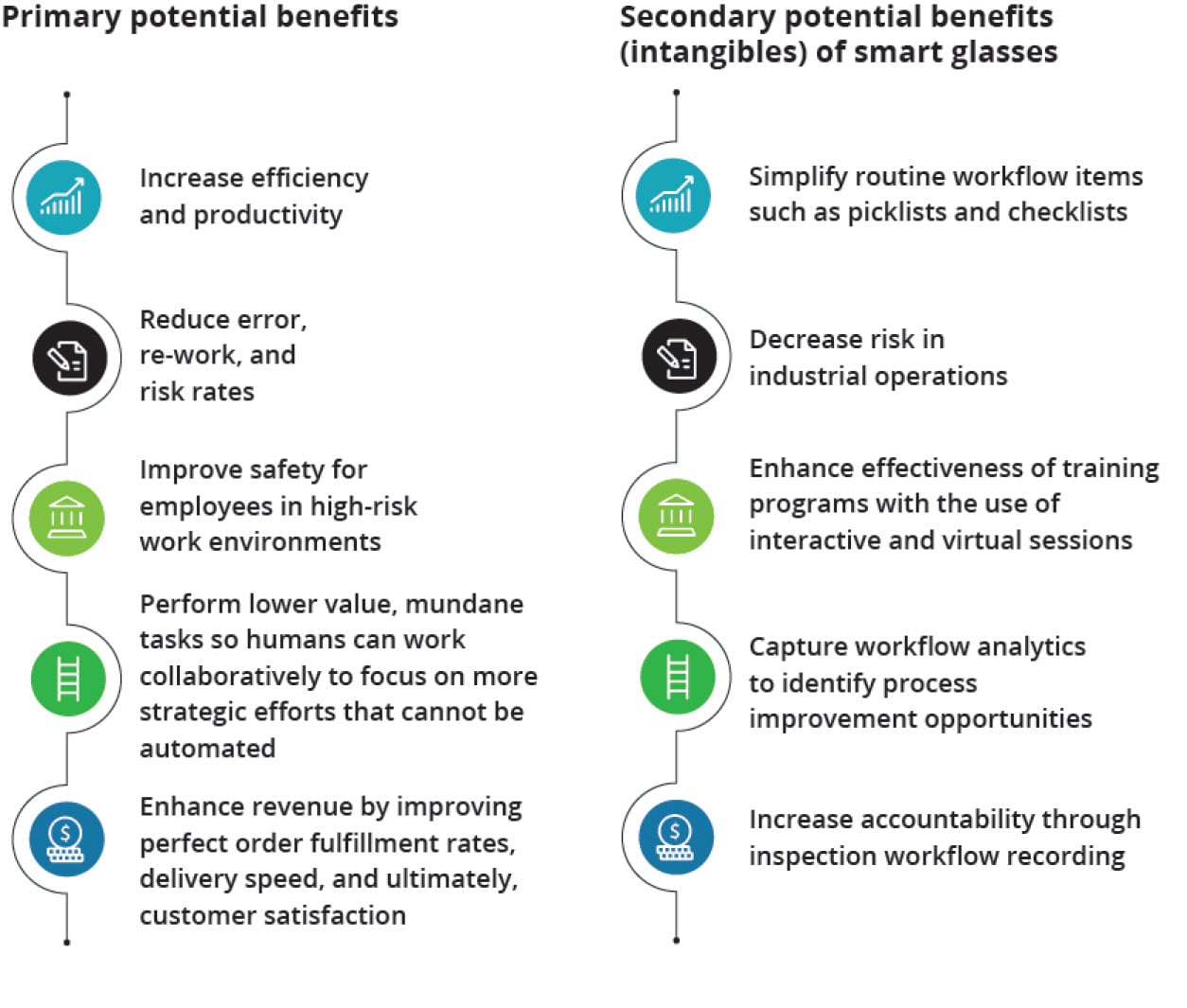Using smart glasses to drive supply chain innovation has been saved

Perspectives
Using smart glasses to drive supply chain innovation
Wearable devices increase productivity and efficiency
Smart glasses and mixed reality wearable devices are helping drive supply chain innovation in the consumer products, life sciences and healthcare, and energy and resources industries. Adoption of these hands-free technologies can increase productivity and efficiency in operations, while improving quality and accountability.
Explore content
- Perspective fundamentals
- Benefits of smart glasses and augmented reality
- Evaluation and adoption
- Smart glasses in your supply chain
- Getting started
Perspective fundamentals: Smart glasses and mixed reality wearable devices
Smart glasses and augmented or mixed reality head-mounted displays (HMDs) are wearable electronic devices that interface between humans and computing through various forms of a heads-up display. Smart glasses typically have multiple features to allow users to both display and analyze information relevant to their surroundings. With augmented or mixed reality, digital projections are overlaid onto real life objects, providing contextual information and allowing users to visually manipulate their surroundings.
Smart glass technology is already advancing in hands-on industries such as manufacturing, logistics, field services, inspection, and operations. A recent study showed that 93 percent of large industrial companies are either using or evaluating smart glasses in their enterprises today, indicating that decision-makers foresee wearables becoming an integral enterprise platform.1
Smart glasses and augmented reality devices have the potential to enhance and even replace existing technology solutions within enterprise supply chains, and, in some cases, even change the very structure of the work environment. Companies implementing augmented reality HMD pilots are already demonstrating use cases that lead to increases in workplace efficiency, productivity, and compliance.
Deloitte and Upskill strategic alliance
The strategic alliance between Deloitte and Upskill (formerly APX Labs) combines Deloitte's leadership in consulting services with Upskill's Skylight software products—a platform company can use to create smart glasses applications. Skylight powers smart glasses and other wearable devices for use across manufacturing, field services, and logistics to measurably and immediately improve productivity, quality, safety, utilization, and compliance.
Benefits of smart glasses and augmented reality in the supply chain
When used effectively in the right settings, smart glasses, and AR displays have a number of important advantages over computers, tablets, and other existing technology: Contextualized information, increased workflow standardization, hands-free assistance, and documentation.

Evaluation and adoption: Supply chain operational considerations
To adopt smart glasses and augmented reality HMDs for supply chain innovation, start by understanding where you will use the technology and how your organization could adopt it. The following five attributes can help shape your decisions and determine the potential overall return on your company's smart glasses investments.
- Functional deployment. Complex, repeated tasks that benefit from improvement in standardization may offer the best initial deployment of smart glasses and wearable devices. Understanding which functions, facilities, and individuals should be the first adopters will be critical to a successful rollout.
- Technology infrastructure. Smart glass and augmented reality device success depends on facilitating interaction with the right data through integration with components of a company's IT ecosystem. In doing so, smart glasses can become a part of the workflow rather than a separate technology, seamlessly receiving and transferring data with enterprise systems, software, applications, and external devices.
- Security. Security is another major concern and a potential barrier to the adoption of smart glasses. Given the capabilities of smart glasses to record and transmit data easily, companies will need to set restrictions on certain smart glass capabilities to protect their employees and customers.
- Regulations. Industry regulation is an existing area of uncertainty for smart glasses. In many industries, devices must comply with Occupational Safety and Health Administration (OSHA), Federal Communications Commission (FCC), Underwriters Laboratories (UL), American National Standards Institute (ANSI), and other industry-specific requirements. According to the ANSI, both the physical smart glass frame and the computing equipment must pass performance standards for equipment worn in the workplace.2
- Operating environments and perception. Companies looking to adopt augmented reality technology need to understand their employees' experience level with mobile devices and comfort with technological change. Appropriate training and change management processes can be implemented to help ease this transition and drive adoption.

Smart glasses in your supply chain. Motivation for action.
The time for companies to assess supply chain innovation for smart glasses and augmented reality adoption is now. Leading companies across a host of industries are piloting and implementing smart glass technology within their organizations; they see the value of this technology within the supply chain and want to keep pace with the wave of innovation.
Enterprises with critical use cases for smart glasses and augmented reality that are not currently exploring this technology will soon find themselves playing catch-up to their peers. As the technology continues to mature at a rapid pace, driving down costs and improving technical capabilities, the business case for piloting smart glasses becomes ever clearer. But, as is the case with other technological shifts in supply chain innovation, simply placing smart glasses in the organization is not transformative; the real value comes from the process to select, design, apply, and integrate the technology.
Getting started with smart glasses and augmented reality devices
Smart glasses can drive major changes to elements of the supply chain. Like every major change, however, this technology advancement requires a strategic approach to begin deploying within a company. Leaders need to understand that piloting this technology mandates a shift in culture toward innovation, openness, and collaboration. A successful adoption strategy should include four major points.
- Follow the business case.
- Communicate the strategic goals clearly.
- Target and pilot.
- Pick the "champions."
Download the PDF for a deeper dive into these four major points, as well as further analysis on how smart glasses and augmented reality technology can be used for supply chain innovation.
1. Upskill Report [LM1] (2015), The State of Enterprise Wearables.
2. https://greenlightinsights.com/augmenting-enterprise-ar-smart-glasses/.

Explore more
| Interested in learning more about supply chain trends? View our other reports on supply chain innovation | |
| Learn more about how organizations are achieving operational performance breakthroughs as digital supply networks enable supply network visibility—and unprecedented insights in manufacturing. |
Recommendations
Using autonomous robots to drive supply chain innovation
Future trends in supply chain
Smart sensors and supply chain innovation
Advanced platforms create digital insights




